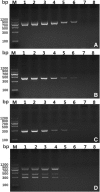A multiplex PCR for differential detection of Echinococcus granulosus sensu stricto, Echinococcus multilocularis and Echinococcus canadensis in China
- PMID: 31362789
- PMCID: PMC6668063
- DOI: 10.1186/s40249-019-0580-2
A multiplex PCR for differential detection of Echinococcus granulosus sensu stricto, Echinococcus multilocularis and Echinococcus canadensis in China
Abstract
Background: Echinococcosis caused by Echinococcus is one of the most major infectious diseases in north-west highland of China. E. granulosus sensu strict, E. multilocularis, and E. canadensis are known to be the only three species related to human health transmitting in the areas. To achieve targeted treatment and control of echinococcosis, the accurate identification and discrimination of the species are important. However, currently the available diagnostic approaches do not present ideal results either in accuracy or efficiency.
Methods: In the study, a set of primers were designed to aim at the three human-pathogenic Echinococcus species in China. The one-step multiplex PCR assay was developed and evaluated for the specificity and sensitivity. A total of 73 parasitic lesions and 41 fecal materials obtained from human and various animals collected in the clinic and the field were tested to assess the applicability of this method.
Results: The multiplex PCR effectively detected the individual DNA from the targeted species and their random mixtures generating with distinguishable expected size of products. The detection limit of the assay for each of the three species was 5 pg/μl when they were tested separately. When DNA mixtures of the targeted species containing the same concentration were used as templates, the lowest amount of DNA which can be detected was 50 pg/μl, 10 pg/μl and 5 pg/μl for E. granulosus s. s., E. multilocularis, and E. canadensis respectively. No cross-reactivity was observed when DNA from eight genetically close species was used as control templates. The multiplex PCR identifications of all samples were in line with the original sequencing results except for those infected with E. shiquicus, which showed negative signals in the developed assay. Of all the tested stool materials, 16 were previously found positive for Echinococcus by visual and microscopic examination. Among these 16 samples, 13 were confirmed by the multiplex PCR, and the other three tested negative. Additionally, the multiplex PCR identified another 14 positive feces from the remained 25 stool samples which absence of worms.
Conclusions: The developed multiplex PCR shows advantages in fast diagnosis and large-scale epidemiological investigation, which proven to be a promising tool utilized in clinic and surveillance system.
Keywords: Echinococcosis; Echinococcus canadensis; Echinococcus granulosus s. s.; Echinococcus multilocularis; Multiplex PCR.
Conflict of interest statement
The authors declare that they have no competing interests.
Figures



Similar articles
-
A multiplex PCR for the identification of Echinococcus multilocularis, E. granulosus sensu stricto and E. canadensis that infect human.Parasitology. 2019 Oct;146(12):1595-1601. doi: 10.1017/S0031182019000921. Epub 2019 Jul 31. Parasitology. 2019. PMID: 31307567
-
Discrimination between E. granulosus sensu stricto, E. multilocularis and E. shiquicus Using a Multiplex PCR Assay.PLoS Negl Trop Dis. 2015 Sep 22;9(9):e0004084. doi: 10.1371/journal.pntd.0004084. eCollection 2015 Sep. PLoS Negl Trop Dis. 2015. PMID: 26393793 Free PMC article.
-
[Detection of Echinococcus granulosus and Echinococcus multilocularis in cyst samples using a novel single tube multiplex real-time polymerase chain reaction].Mikrobiyol Bul. 2016 Apr;50(2):266-77. doi: 10.5578/mb.21005. Mikrobiyol Bul. 2016. PMID: 27175499 Turkish.
-
Cystic Echinococcosis.J Clin Microbiol. 2016 Mar;54(3):518-23. doi: 10.1128/JCM.02420-15. Epub 2015 Dec 16. J Clin Microbiol. 2016. PMID: 26677245 Free PMC article. Review.
-
The present situation of echinococcosis in Europe.Parasitol Int. 2006;55 Suppl:S187-91. doi: 10.1016/j.parint.2005.11.028. Epub 2005 Dec 13. Parasitol Int. 2006. PMID: 16352465 Review.
Cited by
-
Development of Loop-Mediated Isothermal Amplification Combined with Lateral Flow Dipstick Assay for a Rapid and Sensitive Detection of Cystic Echinococcosis in Livestock in Kenya.J Trop Med. 2022 Feb 27;2022:4928009. doi: 10.1155/2022/4928009. eCollection 2022. J Trop Med. 2022. PMID: 35265138 Free PMC article.
-
An exceptional case of peritoneal cystic echinococcosis in a domestic cat in Australia.Aust Vet J. 2025 May;103(5):254-260. doi: 10.1111/avj.13427. Epub 2025 Feb 17. Aust Vet J. 2025. PMID: 39957497 Free PMC article.
-
Establishing and evaluation of a polymerase chain reaction for the detection of Echinococcus multilocularis in human tissue.PLoS Negl Trop Dis. 2021 Feb 25;15(2):e0009155. doi: 10.1371/journal.pntd.0009155. eCollection 2021 Feb. PLoS Negl Trop Dis. 2021. PMID: 33630840 Free PMC article.
-
Diagnostic urinary cfDNA detected in human cystic echinococcosis.Mol Biochem Parasitol. 2020 Sep;239:111314. doi: 10.1016/j.molbiopara.2020.111314. Epub 2020 Aug 28. Mol Biochem Parasitol. 2020. PMID: 32866606 Free PMC article.
-
A Sarcopenia-Based Prediction Model for Postoperative Complications of ex vivo Liver Resection and Autotransplantation to Treat End-Stage Hepatic Alveolar Echinococcosis.Infect Drug Resist. 2021 Nov 23;14:4887-4901. doi: 10.2147/IDR.S340478. eCollection 2021. Infect Drug Resist. 2021. PMID: 34848980 Free PMC article.
References
-
- Wu WP, Wang H, Wang Q, Zhou XN, Wang LY, Zheng CJ, et al. A nationwide sampling survey on echinococcosis in China during 2012-2016. Chin J Parasitol Paras Dis. 2018;36(01):1–14.
MeSH terms
Grants and funding
LinkOut - more resources
Full Text Sources

